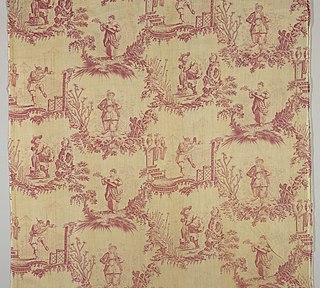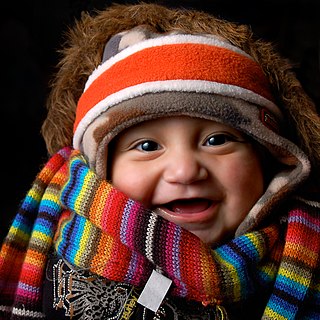

Gossamer fabric is a thin, sheer woven fabric. The structure of the fabric is similar to a gauze. It is usually made of silk, cotton, or wool. The fabric may be coated with rubber to make it waterproof. [1] [2] [3]


Gossamer fabric is a thin, sheer woven fabric. The structure of the fabric is similar to a gauze. It is usually made of silk, cotton, or wool. The fabric may be coated with rubber to make it waterproof. [1] [2] [3]
The name of the fabric is said of something very fine and delicate, [4] and it is associated with a thread-like filmy substance spun by small spiders. [5]
The Gossamer is a very delicate and a see-through fabric. It is used in veils, dresses, long streamers, [6] curtains, and decorations. [7] [1]

Textile is an umbrella term that includes various fiber-based materials, including fibers, yarns, filaments, threads, different fabric types, etc. At first, the word "textiles" only referred to woven fabrics. However, weaving is not the only manufacturing method, and many other methods were later developed to form textile structures based on their intended use. Knitting and non-woven are other popular types of fabric manufacturing. In the contemporary world, textiles satisfy the material needs for versatile applications, from simple daily clothing to bulletproof jackets, spacesuits, and doctor's gowns.

Yarn is a long continuous length of interlocked fibres, used in sewing, crocheting, knitting, weaving, embroidery, ropemaking, and the production of textiles. Thread is a type of yarn intended for sewing by hand or machine. Modern manufactured sewing threads may be finished with wax or other lubricants to withstand the stresses involved in sewing. Embroidery threads are yarns specifically designed for needlework. Yarn can be made of a number of natural or synthetic materials, and comes in a variety of colors and thicknesses. Although yarn may be dyed different colours, most yarns are solid coloured with a uniform hue.

Muslin is a cotton fabric of plain weave. It is made in a wide range of weights from delicate sheers to coarse sheeting. It gets its name from the city of Mosul, Iraq, where it was first manufactured.

Flannel is a soft woven fabric, of varying fineness. Flannel was originally made from carded wool or worsted yarn, but is now often made from either wool, cotton, or synthetic fiber. Flannel is commonly used to make tartan clothing, blankets, bed sheets, and sleepwear.

Percale is a closely woven plain-weave fabric often used for bed covers. Percale has a thread count of about 200 or higher and is noticeably tighter than the standard type of weave used for bedsheets. It has medium weight, is firm and smooth with no gloss, and warps and washes very well. It is made from both carded and combed yarns, and may be woven of various fibers, such as cotton, polyester, or various blends.

Ninon is a lightweight, sheer fabric made with plain or leno weaving, it is a suitable material for curtains, evening wear and lingerie. Ninon is made with variety of filament yarns such as polyester, silk, rayon or nylon.
A staple fiber is a textile fiber of discrete length. The opposite is a filament fiber, which comes in continuous lengths. Staple length is a characteristic fiber length of a sample of staple fibers. A fiber is made up of natural substances and is known for being longer than it is wide. It is an essential criterion in yarn spinning, and aids in cohesion and twisting. Compared to synthetic fibers, natural fibers tend to have different and shorter lengths. The quality of natural fibers like cotton is categorized on staple length such as short, medium, long staple, and extra-long. Gossypium barbadense, one of several cotton species, produces extra-long staple fibers. The staple fibers may be obtained from natural and synthetic sources. In the case of synthetics and blends, the filament yarns are cut to a predetermined length.

Primarily, nap is the raised (fuzzy) surface on certain kinds of cloth, such as velvet or moleskin. Nap can refer additionally to other surfaces that look like the surface of a napped cloth, such as the surface of a felt or beaver hat.
Velcro, officially known as Velcro IP Holdings LLC and trading as Velcro Companies, is a British privately held company, founded by Swiss electrical engineer George de Mestral in the 1950s. It is the original manufacturer of hook-and-loop fasteners, which de Mestral invented.
Bafta is a kind of calico, initially made in India.

Pointelle is a knit fabric pattern with tiny holes typically in the shape of chevrons; the structure is geometric in shape and with repeated design similar to lace. It is a fine knit pattern with small open spaces, subtle stripe, and floral effects. The fabric is lightweight, airy, and of a very delicate nature. Pointelle is possible on warp knitting and weaving also.

Piece goods were the textile materials sold in cut pieces as per the buyer's specification. The piece goods were either cut from a fabric roll or produced with a certain length, also called yard goods. Various textiles such as cotton, wool, silk, etc., were traded in terms of piece goods. The prices were determined as per the fabric quality.

Hand feel is the property of fabrics related to the touch that expresses sensory comfort. It refers to the way fabrics feel against the skin or in the hand and conveys information about the cloth's softness and smoothness. Hand feel is an estimated and subjective property of different fabrics, but nowadays, hand feel could be measured and assessed statistically.
Momie cloth is a pebble-surfaced crêpe structure made of any natural or synthetic yarns. Momie crepe is a light weight material made of cotton.
Huckaback fabric or Huck is a type of toweling cloth with a bird's eye or honeycomb pattern. It is a loosely woven fabric made of cotton or linen with Huckaback weave.
Prunella was an 18th-century worsted fabric also made with a blend of silk. It was produced in Norwich. Prunella was used in a variety of garments such as Petticoats, academic and barristers’ gowns, judges’ robes, coats, waistcoats, and shoes.
Bayadere was an Indian silk fabric with a horizontal stripe pattern.

A gig-mill was type of raising machine that used teasels to produce a nap on cloth. Examples of the results of gigging are woolen fabrics such as chinchilla, beaver cloth, and melton. The process involved gradual teasing of the surface to raise the nap. Spelling in some localities is "Gigg".
Tissue is a thin, transparent, and lightweight material. Tissue fabric is a suitable material for designing various types of garments, including saris. Tissue is characterized by the use of metallic yarns for decorative purposes. The tissue sari is composed of silk threads in the warp and zari in the weft.